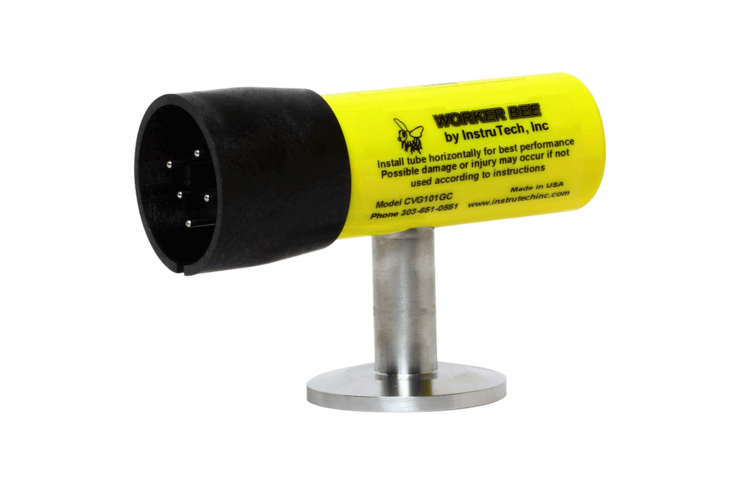CVG101 Worker Bee™ Convection

FAQ
What is the principle of operation?
A convection enhanced Pirani vacuum gauge is a thermal conductivity gauge which measures pressure by sensing the loss of heat from a sensor wire to the surrounding gases. There are several physical effects that remove heat from the sensor. First, heat is removed from the sensor wire through the ends of the wire suspended in the vacuum region by the relatively large mass of the supports that attach the wire to the hermetically sealed electrical connections. Second, heat is removed from the suspended wire via conduction to the gas inside the transducer volume. Heat is also lost from the sensor by thermal radiation. Finally, for the convection enhanced Pirani-type transducer, heat transfer from the sensor is aided by convection currents of the gas at higher pressures inside the transducer volume.
The convection enhanced Pirani gauge operates by maintaining a sensor wire at some constant temperature, and measuring the power required to maintain that temperature. If convection currents, gas conduction, thermal radiation and end-loss heat transfer characteristics are constant, a constant power level delivered to the sensor wire will keep the wire at a constant temperature. If any of the physical effects change, the wire temperature will change. For example if the gas density and pressure around the wire is decreased, the wire will get hotter. If the gas density and pressure around the wire is increased, the wire will be cooled. By monitoring the amount of power required to the keep the sensor wire at a constant temperature, the pressure of the gas can be determined.
What is the measurement range of the CVG101?
- 1.00E-04 to 1,000 Torr
- 1.30E-04 to 1,333 mbar
- 1.30E-02 Pa to 133 kPa
What is the difference between a Convection Enhanced Pirani and a conventional Pirani gauge?
They are both considered thermal conductivity gauges. The convection gauge however utilizes the effect of heat-loss aided by convection cooling to extend the useful measurement range beyond that of the conventional Pirani transducer. Most Pirani vacuum gauge transducers have a useful measurement range of about 1.00E-04 to 1 or 2 torr. Convection Enhanced Pirani-type gauge such as the CVG101 extends the measurement range from 1.00E-04 to 1000 torr.
Does the CVG101 require an external controller to operate?
Yes. The CVG101 is a standalone sensor requiring a vacuum gauge controller to operate. Consider the InstruTech VGC301, B-RAX 3000, B-RAX 3100 or FlexRax 4000.
Which InstruTech controllers can operate the CVG101?
The VCG301, the B-RAX 3000/3100 and the FlexRax 4000.
What is the difference between the CVG101 and CVM201 / CVM211?
The CVG101 is vacuum gauge sensor which requires an external controller to operate. The CVM201 and CVM211 are vacuum gauge modules with a built-in controller and display requiring no other controller to operate.
What are the available output signals from the CVG101?
The signal from the CVG101 has to be processed by a vacuum gauge controller prior to providing an output signal. See your vacuum gauge controller specifications for the available outputs.
Can the CVG101 be installed in any orientation?
Mount the convection gauge with its main (long) axis horizontal. Pressure reading errors may occur above 1 Torr if the unit is not mounted horizontally. Below 1 Torr, mounting position has little to no effect.